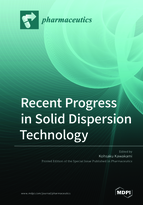Recent Progress in Solid Dispersion Technology
A special issue of Pharmaceutics (ISSN 1999-4923).
Deadline for manuscript submissions: closed (19 May 2019) | Viewed by 54362
Special Issue Editor
Interests: solid dispersion; supersaturation; molecular assemblies; poorly soluble drugs; thermal analysis; polymorphism; solubilization
Special Issues, Collections and Topics in MDPI journals
Special Issue Information
Dear Colleagues,
Amorphous solid dispersion (ASD) has been recognized as a powerful formulation technology to improve oral absorption of poorly soluble drugs for more than half century. Despite such a long history, novel important findings on ASD is still being reported every year. One of the great findings recently is that supersaturation created by ASDs may not be a simple solution but may involve colloidal structure. This knowledge is inevitable to design superior ASD, which can maintain supersaturated state effectively.
Another topic which is actively discussed recently to understand performance of ASD is crystallization behavior of active pharmaceutical ingredients. Solid state stability of ASD, especially the physical stability, is one of the concerns for industrial formulators when ASD is employed, as it cannot be predicted from conventional accelerated testing protocol. General understanding on crystallization of small organic compounds is of great challenge, as their dynamics is affected by both strong (covalent) and weak (noncovalent) interactions, unlike inorganic glasses.
ASDs are mainly manufactured using spray-drying (SD) and hot-melt extrusion (HME). Many requirements exist for both drugs and excipients including high solubility in organic solvents (SD), high (SD) and low (HME) glass transition temperatures, and high thermal stability (HME). Thus, development of a novel manufacturing method and excipient are also grand challenges.
This special issue welcomes any topics regarding recent progress in ASD technology as exampled above but not limited to.
Dr. Kohsaku Kawakami
Guest Editor
Manuscript Submission Information
Manuscripts should be submitted online at www.mdpi.com by registering and logging in to this website. Once you are registered, click here to go to the submission form. Manuscripts can be submitted until the deadline. All submissions that pass pre-check are peer-reviewed. Accepted papers will be published continuously in the journal (as soon as accepted) and will be listed together on the special issue website. Research articles, review articles as well as short communications are invited. For planned papers, a title and short abstract (about 100 words) can be sent to the Editorial Office for announcement on this website.
Submitted manuscripts should not have been published previously, nor be under consideration for publication elsewhere (except conference proceedings papers). All manuscripts are thoroughly refereed through a single-blind peer-review process. A guide for authors and other relevant information for submission of manuscripts is available on the Instructions for Authors page. Pharmaceutics is an international peer-reviewed open access monthly journal published by MDPI.
Please visit the Instructions for Authors page before submitting a manuscript. The Article Processing Charge (APC) for publication in this open access journal is 2900 CHF (Swiss Francs). Submitted papers should be well formatted and use good English. Authors may use MDPI's English editing service prior to publication or during author revisions.
Keywords
- Amorphous
- Solid dispersion
- Poorly soluble drug
- Supersaturation
- Crystallization
- Stability
- Spray-drying
- Hot-melt Extrusion







